Loans
Prosper Marketplace Posts $18.5M Profit for 2020
March 15, 2021 Prosper Marketplace reported a $18.5M profit for 2020, up from a net loss of $13.7M in 2019, marking yet another online lender that successfully weathered Covid.
Prosper Marketplace reported a $18.5M profit for 2020, up from a net loss of $13.7M in 2019, marking yet another online lender that successfully weathered Covid.
In 2020, Prosper originated $1.5B in loans, $1.4B of which were originated through their Whole Loan Channel.
Like Lending Club, the company has long retreated from its peer-to-peer lending roots, but still operates a platform where individual retail investors can buy notes, whereas Lending Club terminated theirs completely.
Prosper generated $100 million in revenue in 2020 and had 353 full-time employees at year-end.
Prosper is not publicly traded but is required to file regular financial statements with the SEC because it sells notes to retail investors.
LendingClub Talks Earnings Post Radius-Bank Acquisition
March 11, 2021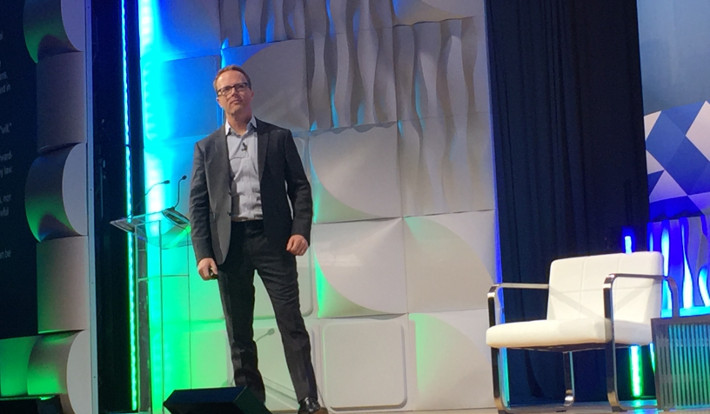 “It’s really hard to imagine a better time to be launching a digital bank,” said LendingClub CEO Scott Sanborn on the company’s Q4 earnings call. “First up, we’ll be building on Radius’ multi-award winning online and mobile deposit offering to make it very easy for our customers to manage their lending, spending and savings in a holistic fashion.”
“It’s really hard to imagine a better time to be launching a digital bank,” said LendingClub CEO Scott Sanborn on the company’s Q4 earnings call. “First up, we’ll be building on Radius’ multi-award winning online and mobile deposit offering to make it very easy for our customers to manage their lending, spending and savings in a holistic fashion.”
The company reported a Q4 net loss of $26.7M on $75.9M in revenue and originated $912M in loans. Their status of being a bank, however, is only just beginning. CFO Tom Casey explained the following:
In addition to lowering our funding cost of deposits, our new marketplace bank will capture significant financial benefits from being a bank and having a marketplace. [….]For every $100 million of loans we originate, we generate about $4 million through an origination and servicing fee when we sell the loans in the marketplace. The vast majority of this fee-based revenue is realized immediately and without requiring a significant amount of capital. However, it is highly dependent on origination volume.
[…]
We can now bolster this revenue stream with bank revenue generated by loans held for investment on our balance sheet. As you can see on the left side of the page, every $100 million of loans we hold on the balance sheet should generate additional marginal profitability of approximately $12 million. And when you compare that to the $4 million in the marketplace, that’s 3 times more. And this recurring revenue is not dependent on originations in any given quarter.
LendingClub experienced unique success during the pandemic, stating that loan performance exceeded their expectations.
“Coming out of the pandemic,” Sanborn said, “the strength of our underwriting has now also been cycle-tested. Losses on loans issued pre-COVID are in line with our pre-pandemic expectations, and loans issued since the pandemic are some of our best-performing loans in recent years.”
Was That Loan Forgiven? The Tax Man Cometh
March 10, 2021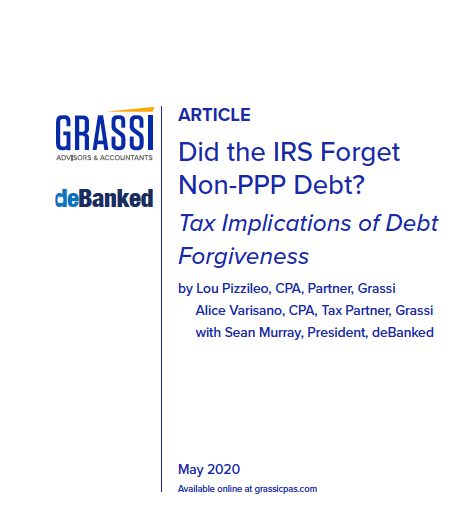 With tax season upon us, the events of 2020 will soon be reviewed and evaluated by everyone’s best friend, the IRS. Lenders that offered debt forgiveness might have done a favor to distressed borrowers in 2020, but a consequence of that courtesy is that the borrowers’ forgiven debt might be taxable.
With tax season upon us, the events of 2020 will soon be reviewed and evaluated by everyone’s best friend, the IRS. Lenders that offered debt forgiveness might have done a favor to distressed borrowers in 2020, but a consequence of that courtesy is that the borrowers’ forgiven debt might be taxable.
This is as good a time as ever to review a report prepared by Grassi Advisors & Accountants whether you are a lender that forgave debt or a borrower that had debt forgiven.
“This issue was noticed early last year,” said deBanked President Sean Murray, “but at the time everyone was so focused on PPP forgiveness, the EIDL program, and government stimulus, that I think the potential consequences of lenders forgiving non-PPP debt for their borrowers were lost in the shuffle. Imagine you’re a borrower that had $100,000 of non-PPP debt forgiven last year and you’re only now about to learn that the IRS may classify that as income. Or worse yet, you don’t even realize it and are told that later on during an audit.”
In May 2020, deBanked labelled this as a hidden tax time bomb that was set to detonate in 2021. And now here we are.
Methodical Ponders if The Roaring Twenties Are Around The Corner
March 9, 2021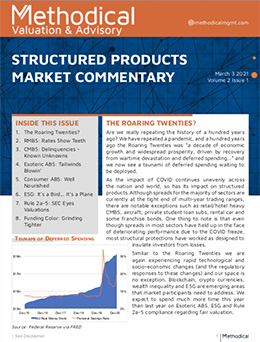 When we last spoke with Gunes Kulaligil, a co-founder of Methodical Management, a valuation and advisory firm, several securitizations in the non-bank finance space had just hit early amortization triggers. That was in late June 2020.
When we last spoke with Gunes Kulaligil, a co-founder of Methodical Management, a valuation and advisory firm, several securitizations in the non-bank finance space had just hit early amortization triggers. That was in late June 2020.
Now that time has passed and the world stabilized, a publication put out by the firm on March 3rd ponders if we are on the verge of repeating the Roaring Twenties of a century ago.
“We have repeated a pandemic, and a hundred years ago the Roaring Twenties was a decade of economic growth and widespread prosperity, driven by recovery from wartime devastation and deferred spending… and we now see a tsunami of deferred spending waiting to be deployed,” the company wrote.
Although spreads for the majority of sectors are currently at the tight end of multi-year trading ranges, there are notable exceptions such as retail/hotel heavy CMBS, aircraft, private student loan subs, rental car and some franchise bonds. One thing to note is that even though spreads in most sectors have held up in the face of deteriorating performance due to the COVID freeze, most structural protections have worked as designed to insulate investors from losses.
“A positive perhaps unexpected consequence of COVID has been the higher savings rates seen than before the pandemic,” the report says. “To be clear, it is a K-shaped recovery and there continues to be distress especially for lower income borrowers, but nowhere near the projected levels pontificated after April 2020’s unemployment number of 14.8% was released. There may continue to be unintended consequences down the road but for now FICOs are up, savings are up, delinquencies are down and this trend is likely to continue as new stimulus packages that are in the works get rolled out.”
NYC Taxi Workers Block Brooklyn Bridge, Demand Debt Forgiveness
February 11, 2021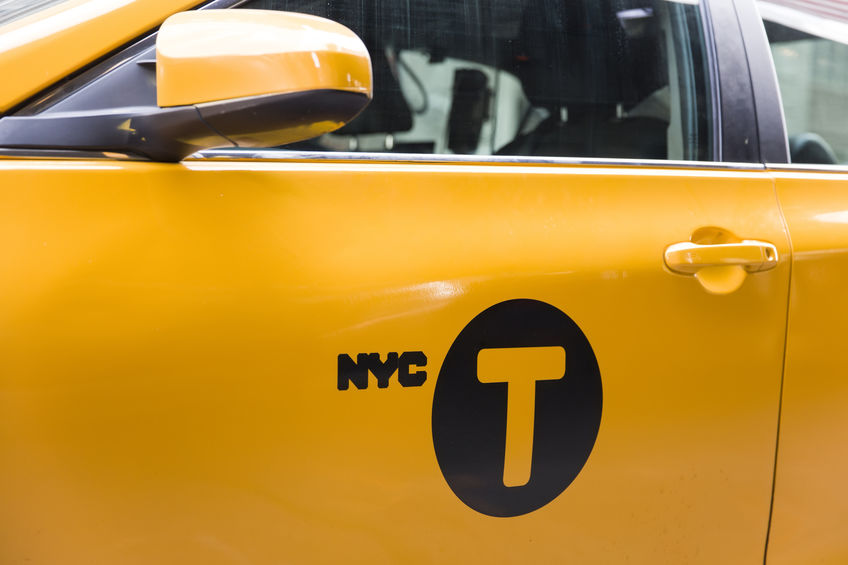 Taxi drivers demanding Medallion debt forgiveness briefly blocked the Brooklyn Bridge Wednesday. The protest, organized by the 21,000-member strong New York Taxi Workers Alliance union (NYTWA), was a release of fury over the astronomical debt they have faced during a global pandemic that has cut ridership by 80%.
Taxi drivers demanding Medallion debt forgiveness briefly blocked the Brooklyn Bridge Wednesday. The protest, organized by the 21,000-member strong New York Taxi Workers Alliance union (NYTWA), was a release of fury over the astronomical debt they have faced during a global pandemic that has cut ridership by 80%.
“Debt forgiveness now,” chanted Union Founder Bhairavi Desai through a megaphone, leading the drivers in a chant. That’s a lot of debt: To get a city-licensed taxi medallion, drivers had to pay inflated prices, up to $1.3M in 2014, before the advent of rideshare apps crashed prices to a fraction of what they were worth.
We shut down the Brooklyn Bridge because only direct action will get us what we need: medallion debt forgiveness now! pic.twitter.com/kmbQlBrOO3
— NY Taxi Workers (@NYTWA) February 10, 2021
In 2021, thousands of taxi drivers are paying up to $600,000 in debt on medallions that are only worth $120-$150k. Last year, Desai testified before the State House Financial Services Committee that Confessions of Judgment were used extensively to take hundreds of thousands in debt from the pockets of taxi drivers.
The day of action started with a gathering of union members at the mayor’s office at 9 am before senior members (62 yo+) testified that the medallion crash stole retirement savings at a City Council Committee on Immigration.
Dozens of taxis then formed a motorcade, blocking the bridge before gathering at the Park Slope home of Senator Chuck Schumer, Democratic Majority leader of the Senate, who NYTWA said is leading negotiations over the stimulus bill.
Protestors could be seen across from the north entrance to Prospect Park to encourage Schumer’s support to push bill H.R. 5617 through Congress. The Taxi Medallion Loan Forgiveness Debt Relief Act will eliminate the need to pay taxes on outstanding medallion debt, the NYTWA website states.
The union also calls for the leveling of taxi medallion debt to $250k per medallion. NYTWA holds that the city helped inflate medallion prices and should assume the leftover debt. The New York Times and Post reported a bailout of that size could top $500M.
“Till pandemic do us part” Divorce on rise, Weddings Furloughed
December 22, 2020 For couples who live together, forced “quality time” due to a pandemic has been considered an exciting change in the household’s dynamic, to say the least.
For couples who live together, forced “quality time” due to a pandemic has been considered an exciting change in the household’s dynamic, to say the least.
Trouble in paradise? Possibly, as one firm found, the amount of people inquiring about divorce loans has risen 62% in 2020, compared to last year.
If you didn’t know divorce loans were an option in the first place, Loanry, an online loan lead generator, said divorces could cost upwards of $12,000 in states like Delaware and New York, and in California up to $14,236.
Loanry looked through their loan transactions and found that not only were divorce loans higher by 68% in New York and 71% in Florida, but the wedding loan business was in trouble.
2020 has been a record year for marriages ending – and hundreds of thousands of couples being unable to hold a wedding in the first place.
According to Statista, over 2 million weddings occur every year in the US, at an average cost of $30,000. Wedding site The Knot found 93% of planned marriages were rescheduled. Loanry found 11% of planned weddings took out loans.
For those of you at home (most of you), couples are paying back $3.7 billion without even saying, “I do.”
Answering the question no one asked: what is the worst way to start a lifelong journey together?
Loanry has sets of advice to deal with the costs of both weddings and divorces, but the simplest seems to be “don’t do either.”
“Financing a wedding using a loan should be taken very seriously, and we don’t recommend it,” Ethan Taub, founder of Loanry.com, said. “Finding ways to cut costs on your wedding expenses is a far more effective alternative to avoid unnecessary debt yet still enjoy your big day.”
He went on to comment that while divorce in this stressful year is sad, make sure to research the best, most affordable option.
NYC Taxi Drivers Protest, deBanked Reporter Goes For a Ride
September 17, 2020 On Thursday, NYC taxi drivers shut down the Brooklyn Bridge to formally protest the financing costs tied to their taxi medallions, the certificate that allows them to operate in the five boroughs. Tensions over “Medallion loans” have been bubbling over since last year when it was revealed that many borrowers had signed a Confession of Judgment to obtain their loan, which basically waived their right to settle any disputes with their lender in court should they be unable to make the payments. Since then, COVID has completely devastated an already suffering industry…
On Thursday, NYC taxi drivers shut down the Brooklyn Bridge to formally protest the financing costs tied to their taxi medallions, the certificate that allows them to operate in the five boroughs. Tensions over “Medallion loans” have been bubbling over since last year when it was revealed that many borrowers had signed a Confession of Judgment to obtain their loan, which basically waived their right to settle any disputes with their lender in court should they be unable to make the payments. Since then, COVID has completely devastated an already suffering industry…
“Before it was good, we could make $100-$150 a day,” said Mohammad Ashref, a local Brooklyn taxi driver in a video interview with deBanked reporter Johny Fernandez. “Now it’s very hard to survive, we work very hard to make 60, 70, or $80 a day, but what can I do? I have to make a living. We have no other choice.”
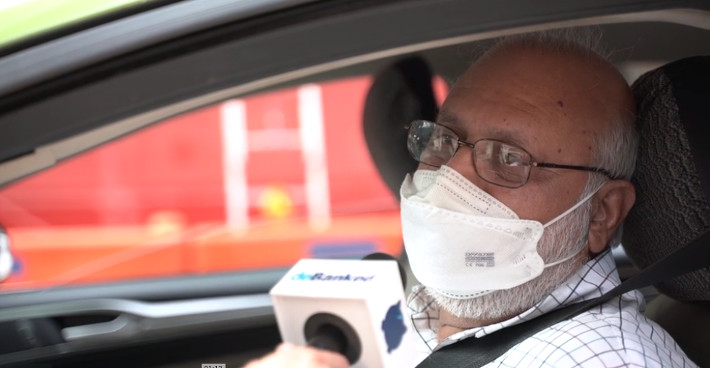 Ashref technically drives a green cab, different from the yellow cabs that were protesting on the bridge in that they’re not permitted to accept street-hails throughout most of Manhattan. Green taxis also operate through a permit rather than a medallion, a still relatively new concept that was first rolled out in 2013 to facilitate ride-hailing in the outer boroughs where yellow cabs did not spend much time.
Ashref technically drives a green cab, different from the yellow cabs that were protesting on the bridge in that they’re not permitted to accept street-hails throughout most of Manhattan. Green taxis also operate through a permit rather than a medallion, a still relatively new concept that was first rolled out in 2013 to facilitate ride-hailing in the outer boroughs where yellow cabs did not spend much time.
In the interview with Fernandez, Ashref pointed out that the success of the taxi business is intertwined with the restaurant industry. Many riders in the boroughs depend on cabs to take them to restaurants or night clubs, but with the complete ban on indoor dining still in effect within city limits, that need has mostly dried up.
According to the NYC Taxi & Limousine Commission, yellow and green cabs were making as little as $314 and $210 a week respectively during the peak period of the shutdowns. In a 40 hour week, these amount to a fraction of the $15/hour local minimum wage and that’s even before factoring in driver costs like a vehicle lease, loan payments, insurance, and more.

deBanked has been exploring several areas of the New York City economy over the last few months. For instance in July, reporter Johny Fernandez looked into how the pandemic was affecting a street performer in Times Square that was dressed as Batman.
“The business now is slow,” Batman said. “There’s so few people at this moment […] At this moment I see people scared, they don’t want pictures…”
Batman, like others in New York City, was hopeful that a return to normalcy was just around the corner.
What is ‘Lending as a Service?’
September 3, 2020I‘ve heard of SaaS, but now there’s LaaS, Lending as a Service. I recently spoke with Timothy Li, CEO of Alchemy, a fintech infrastructure company that offers that and more. You can check it out below!





























